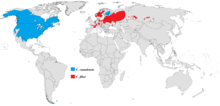| Beaver Temporal range: Late Miocene – Recent
| |
|---|---|

| |
| North American beaver (Castor canadensis) | |
| Scientific classification | |
| Domain: | Eukaryota |
| Kingdom: | Animalia |
| Phylum: | Chordata |
| Class: | Mammalia |
| Order: | Rodentia |
| Family: | Castoridae |
| Subfamily: | Castorinae |
| Genus: | Castor Linnaeus, 1758 |
| Type species | |
| Castor fiber[1] Linnaeus, 1758
| |
| Species | |
| |

| |
| Range of the living beavers as of 2016 (including introduced C. canadensis populations in Europe and Patagonia, but missing C. fiber populations in Mongolia and northwestern China, as well as reintroduced populations in the United Kingdom)[needs update?] | |
Beavers (genus Castor) are large, semiaquatic rodents of the Northern Hemisphere. There are two existing species: the North American beaver (Castor canadensis) and the Eurasian beaver (C. fiber). Beavers are the second-largest living rodents, after capybaras, weighing up to 50 kg (110 lb). They have stout bodies with large heads, long chisel-like incisors, brown or gray fur, hand-like front feet, webbed back feet, and tails that are flat and scaly. The two species differ in skull and tail shape and fur color. Beavers can be found in a number of freshwater habitats, such as rivers, streams, lakes and ponds. They are herbivorous, consuming tree bark, aquatic plants, grasses and sedges.
Beavers build dams and lodges using tree branches, vegetation, rocks and mud; they chew down trees for building material. Dams restrict water flow, and lodges serve as shelters. Their infrastructure creates wetlands used by many other species, and because of their effect on other organisms in the ecosystem, beavers are considered a keystone species. Adult males and females live in monogamous pairs with their offspring. After their first year, the young help their parents repair dams and lodges; older siblings may also help raise newly born offspring. Beavers hold territories and mark them using scent mounds made of mud, debris, and castoreum—a liquid substance excreted through the beaver's urethra-based castor sacs. Beavers can also recognize their kin by their anal gland secretions and are more likely to tolerate them as neighbors.
Historically, beavers have been hunted for their fur, meat, and castoreum. Castoreum has been used in medicine, perfume, and food flavoring; beaver pelts have been a major driver of the fur trade. Before protections began in the 19th and early 20th centuries, overhunting had nearly exterminated both species. Their populations have since rebounded, and they are listed as species of least concern by the IUCN Red List of mammals. In human culture, the beaver symbolizes industriousness, especially in connection with construction; it is the national animal of Canada.
- ^ International Commission on Zoological Nomenclature (1922). "Opinion 75. Twenty-Seven Generic Names of Protozoa, Vermes, Pisces, Reptilia and Mammalia Included in the Official List of Zoological Names". Smithsonian Miscellaneous Collections. 73 (1): 35–37. Archived from the original on January 23, 2022. Retrieved January 23, 2022.